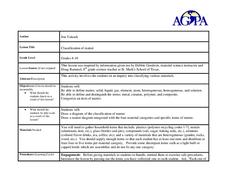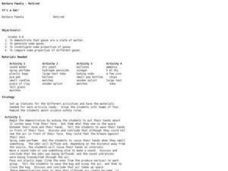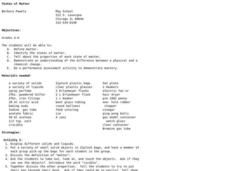Curated OER
Gases Lighter and Heavier than Air
Learners explore the concept of air density. In this air density lesson plan, students fill balloons with helium and carbon dioxide. Learners determine which gases are heavier or lighter than air.
Curated OER
Classification of Matter
Students investigate common household items and classify them into types of matter. In this matter lesson, students group given items into categories based on their characteristics. They also complete a concept map about matter and...
Curated OER
Chemistry Is a Gas
Students investigate the gas laws and how they apply to changes in gases. In this gas laws lesson, students use Boyle's Law and Charles' law to show the relationships between pressure and volume and volume and temperature of gases.
Curated OER
It's The States of Matter
Students investigate the properties of solids, liquids and gases. In this states of matter lesson plan, students observe dry ice and its characteristics. They calculate the density of dry ice and observe the sublimation of the dry ice...
Curated OER
It's a Gas!
Students investigate gases and their properties by completing 4 activities. In this gases lesson plan, students perform activities to show that gases take up space, they diffuse, and that odors and vibrations pass through gases. They...
Curated OER
Change of State
Students investigate the change of states of Butyl Stearate and the temperatures at which it changes state. In this change of state lesson plan, students place a test tube of Butyl Stearate in a cold water bath and monitor its...
Curated OER
What is a Gas?
Students develop a scientific model of gas behavior. For this gas lesson plan, students observe different balloons filled with different densities of gases. They complete an activity where they model the behavior of gases using marbles,...
Curated OER
Using a Spreadsheet to Solve Gas Law Problems
Students use a spreadsheet to solve gas law problems. In this gas laws lesson plan, students use the Express Calc program to load a spreadsheet for the gas law problems. Students compute volume, temperature, or pressure according to the...
Curated OER
Popcorn Is a Gas
Students investigate why and how popcorn pops. In this gas lesson plan, students observe and make suggestions as to what causes popcorn to pop after observing popped corn and corn kernels. Students mass the kernels before and after...
Curated OER
States of Matter
Students examine the properties of solids, liquids, and gasses. In this states of matter lesson plan, the teacher guides students through a series of experiments to illustrate each state of matter and how matter changes from one state...
Curated OER
States of Matter
For this states of matter worksheet, high schoolers answer 4 questions about solids, liquids, gases and plasma. They compare the particles of each and draw diagrams showing the particles in each state of matter.
Curated OER
Behavior of Gases
For this gas behavior worksheet, students answer 5 questions about gases, how pressure, altitude and temperature effect the behavior of gases and about Gay-Lussac's Law.
Curated OER
Heat Transfer & Phase Changes
In this heat transfer and phase change worksheet, students experiment with ice, salt, and milk to show the relationship between the temperature of a solution and its phase. Students turn milk from a liquid to a solid and graph the...
Curated OER
Solid, Liquid or Gas?
Students explore solid, liquids, and gases. In this science lesson plan, students distinguish similarities and differences of matter and recognize that different states of matter may appear in one substance.
Curated OER
What A Gas!
Students study various aspects of air. In this science lesson plan, students discover that air occupies space, understand the visual effects of air, and explain how air exerts force.
Curated OER
Introduction to Gases
Students are introduced to gases. For this science lesson plan, students demonstrate that gases are a state of matter, generate a number of gases, discover some properties of gases, compare some of the properties of different gases, and...
Curated OER
The Conservation Of Mass (The Mass Of Gas)
Middle schoolers gain an understanding of matter in all of its phases. In this science lesson plan, students further their knowledge of the laws of conservation of mass, the loss in mass can be accounted for, when the gas is allowed to...
Curated OER
Matter and Energy
In this matter and energy worksheet, students identify substances as solids, liquids or gases, they use the kinetic theory to describe the motion of particles and they explain the conservation of mass and energy when a substance changes...
Curated OER
States of Matter
In this states of matter worksheet, students read about the changes in energy for matter to go from one state to another state. They complete a chart for each state of matter and identify the shape, the volume, its compressibility, the...
Curated OER
Applying Avogadro's Law
In this Avogadro's law activity, learners read about gases and learn that under the same conditions of pressure and temperature gases with equal volumes have the same number of moles of particles. Students use Avogadro's law to solve 8...
Curated OER
Dissolving Solids and Gases
In this dissolving solids and gases worksheet, high schoolers learn that the process of dissolving gas is opposite of the process of dissolving solids. Students answer 3 critical thinking questions about dissolving gases and solids in...
Curated OER
Gas Stoichiometry
In this gas stoichiometry worksheet, students use the ideal gas law and balanced chemical equations to solve for unknown values such as volume and mass of gases.
Curated OER
Comparing Solids, Liquids, and Gases
In this solids, liquids and gases worksheet, learners observe a teacher demonstration about gases and they experiment with liquids to show diffusion, shape and volume. They answer nine questions about the experiments related to solids,...
Curated OER
Color Coding the Periodic Table
In this periodic table worksheet, students color code the periodic table to show groups of elements, the states of elements, if they are man-made or synthetic elements, if they are radioactive and the number of electrons in their outer...

























